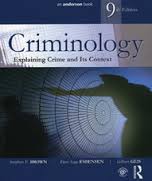Author: Stephen E Brown, Finn-Aage Esbensen and Gilbert Geis
ISBN No: 9780323356480
Review date: 25/04/2024
No of pages: 620
Publisher: Routledge
Publisher URL:
http://routledgetextbooks.com/textbooks/9780323356480/
Year of publication: 10/09/2015
Brief:
Criminology: Explaining Crime and Its Context, ninth edition textbook offering perspective on criminological theory
Criminology: Explaining Crime and Its Context is an American textbook, now in its ninth edition.
If you are taking a master’s degree or other course in security management or a related subject, it seems daft to spend perhaps thousands of pounds on the course, and to turn your nose up at spending a fraction of that on books to go with that learning. For instance the second edition of Prof Tim Newburn’s Criminology, that we reviewed in 2013. As a professor of criminology at the London School of Economics, he could take a British perspective. While Brown, Esbensen and Geis’ work is North American-based (Geis died in 2012 aged 87), that need not matter to UK readers, for one thing because so much of the evidence put forward is about as well known or as fascinating as any – whether gangs in Los Angeles and Chicago or David L Sokol, the senior man at Warren Buffett’s business empire, who resigned in a 2011 scandal.
Another point that may put off students before they buy any textbook, let alone one in particular, is that so much is available online – take Tim Newburn’s own LSE page, for instance. Likewise, a companion website for Criminology: Explaining Crime put together by Kyle Burgason, Assistant Professor of Criminology and Criminal Justice, offers electronic flashcards and practice quizzes for students and teaching materials for instructors, including Instructor’s Guides, PowerPoint Presentations, Figures and Tables Slides, and a Test Bank. Why bother with a print book?!
Corporate security people may turn to the chapter on ‘economic crime’, so often overlooked by academic criminologists or damned in a left-wing diatribe about crimogenic capitalism. Not so here. In the couple of pages on that ‘Sokol scandal’ for instance, the authors end by asking whether ‘they were seeing a case of a brazen white-collar criminal or that of a shrewd businessman, although they appreciated that a gap in the law that failed to prohibit what Sokol had done was a big part of the issue’. The authors point to similar pressures on people in business, medical scientists straining for a research breakthrough; or sports coaches under pressure to win; in all cases the temptation is to ‘resort to criminal resolutions’. Here as throughout the book the authors bring in theory without ruining the flow of their argument or crushing their style of writing. The book suggests that white-collar crime ‘is a much more serious threat to the vitality and integrity of a society than street crime because it destroys trust in the country’s leaders’. Such crime is by people of power and status, but (keeping in mind that so few if any were prosecuted for fraud related to the credit crunch of 2008 and the economic and banking downturn after) there are what the authors call ‘definitional dilemmas’ – such as; is what business people do against the law, or just immoral or even the norm, what you do to acquire money and goods? Besides, what if the victim doesn’t notice – that they’ve been sold counterfeit or sub-standard goods, or mis-sold a pension. That chapter like others ends with pages of further reading, largely American.
Just to go back to that ‘crimogenic’ point that many eager criminologists trumpet; the authors do cover ‘corporate, government and professional violence’, suggesting that illegal dumping and exposure of workers to asbestos are examples of corporate violence. The concept here is ‘the relativity of crime’; that is detailed early on. Some behaviours are, depending on time and culture, and who says so, laudable or conforming (maybe not admirable), deviant or criminal – as the book puts it, a ‘continuum’. Take drugs (legal and illegal) for example.
This textbook then not only goes through types of crimes, and how and why criminals do crimes, but even whether something is a crime or something else. The book neither avoids nor is the slave of theory. It shows that criminology matters to the law, politics and society, and is changing as society changes. You can read this with profit to be a better and more informed citizen, besides a working security manager.
One quibble would be that little is said about cyber crime.
A word about the writing style. Neither preachy nor sitting on the fence, the book feels well laid out and strikes the right balance between covering so much ground, and being easy to follow.
Contents
1 Crime and Criminology, 2 The Relativity of Law and Crime, 3 Production of Crime Statistics, 4 Distribution of Crime, PART 2 Theories of Crime, 5 Deterrence and Rational Choice Theories of Crime, 6 Individual Theories of Crime: A Biosocial Perspective, 7 Social Structure Theories of Crime, 8 Social Process Theories of Crime, 9 Social Reaction Theories of Crime, 10 New Directions: Integration and a Life-Course Perspective, PART 3 Types of Crime, 11 Violent Crime, 12 Economic Crime, 13 Crimes without Victims and Victims without Crimes, 14 Youth Violence.









